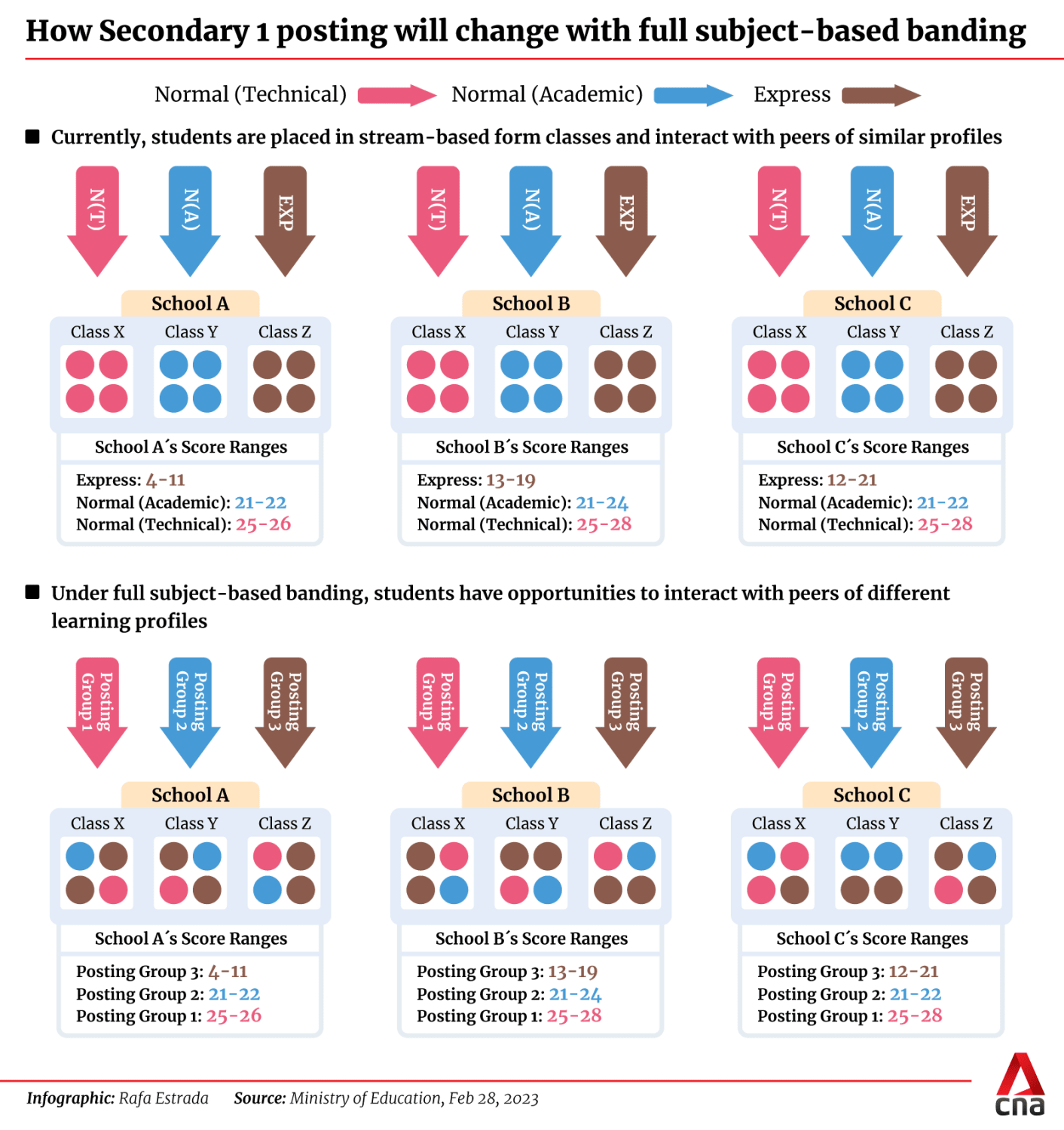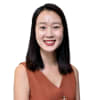Students to enter secondary school via posting groups mapped from current streams; form classes will be mixed
A common Singapore-Cambridge Secondary Education Certificate exam will replace the O-Levels and N-Levels from 2027.
SINGAPORE: Starting from the 2024 Secondary 1 batch, all students will be posted into secondary schools in three groups, mapped from the existing score ranges for the Express, Normal (Academic) and Normal (Technical) streams.
The three posting groups will be used to facilitate school admission and guide the subject levels students offer at the start of the year, said the Ministry of Education (MOE).
“Beyond that, posting groups will not shape the secondary school experience,” said Minister for Education Chan Chun Sing in his speech during the Committee of Supply debates on Wednesday (Mar 1).
This ensures that schools continue to admit students with diverse strengths, and students continue to have access to a wide range of schools, he added.
“By admitting students from different posting groups, schools can also enable diversity at the class level, with mixed form classes that comprise students offering subjects at different subject levels,” said Mr Chan.
In schools that take in students from multiple posting groups, mixed form classes mean each class will be made up of students from different posting groups, taking subjects at different levels.
With full subject-based banding implemented across 120 schools from next year, students will sit for a common Singapore-Cambridge Secondary Education Certificate (SEC) exam from 2027, regardless of their initial posting group.
The SEC will replace the current O-Level and N-Level certificates, which current students sit for at the end of four or five years in secondary school.
The option of spending a fifth year in secondary school will remain available to students who want to take subjects at a more demanding level, said Mr Chan.
About 80 per cent of secondary schools will implement full subject-based banding, said MOE.
The remaining schools include integrated programme schools such as Raffles Institution, which only accept students from posting group 3 – currently the Express stream. Crest Secondary School will also remain a specialised school that offers a customised curriculum for students in posting group 1 – currently the Normal (Technical) stream.
However, these schools can still allow students to take subjects at a more demanding or less demanding level, said MOE.
Currently, students can already take English, mathematics, science and mother tongue at a higher level in Secondary 1 if they did well in the subjects at the PSLE. This option will be expanded to humanities subjects at Secondary 2 from 2024.
Previously, without mixed form classes and full subject-based banding, a school that accepted students from all three streams would typically see classes made up of only Express students, N(A) students or N(T) students. These students would also only take subjects at the level of their stream and then take the corresponding O-Level or N-Level examinations.
But with the removal of streams and the start of full subject-based banding from 2024, students will have classmates from different posting groups.

With full subject-based banding, students can now take subjects at a G3, G2 or G1 level, mapped from the current Express, N(A) and N(T) standards.
A student who enters a school under posting group 3 will start off with mostly G3 subjects. A student who enters under posting group 2 will start off with mostly G2 subjects, but may be offered the option to take some at a G3 level depending on their PSLE results or if they do well later on.
Students will take core subjects like science, mathematics or English in classes according to their subject level, which means a subject class could be made up of students from posting groups 2 and 3, with all of them taking the subject at a G3 level.
In lower secondary, they will take six common curriculum subjects in their mixed form classes - art, design and technology, food and consumer education, music, physical education and character and citizenship education.
HOW WILL THE POSTING GROUPS WORK?
After students take the Primary School Leaving Examination (PSLE), their results will reflect whether they are in posting group 3, 2 or 1.
Students who score between 4 and 20 points will be in posting group 3, and those who score between 23 and 24 points will be in posting group 2, said MOE.
Those who score 26 to 30 points, with an Achievement Level of 7 in English and mathematics, will be in posting group 1. Students who score 21 or 22 points will be put in an option band, and can choose to apply as a student from posting group 2 or 3. Students who score 25 points can choose between applying under posting group 1 or 2, the Education Ministry said.

Currently, students who score within these option bands can already choose to apply for schools at an Express or N(A) level, and N(A) or N(T) level respectively. Each school will continue to have a different cut-off point range for each posting group it accepts.
For example, a student in the first option band may apply to Bendemeer Secondary School, which accepts students from posting groups 1, 2 and 3. They can choose to apply under posting group 2 or 3.
This student may then go on to enter the school under posting group 2, and eventually take some subjects at a G3 level.
Under full subject-based banding, students can also choose to take subjects at a less demanding level if they are not coping well, said MOE. From 2026, some of these subjects will also be offered electives at more demanding or less demanding levels.
This is to encourage students to take subjects based on their interests, said MOE.
For example, computer applications is currently a standalone subject for lower secondary N(T) students.
This will be discontinued, and computing will be offered as an elective subject for all upper secondary students from 2026, when the Secondary 1 batch of 2024 reaches Secondary 3.
From the 2024 Secondary 1 cohort, social studies for the N(T) stream will also be discontinued, and replaced by G1 humanities, which is non-examinable.
Most of the elective subjects taken at the upper secondary level are examinable, and there are some elective subjects, like History, that are not offered at the G1 level, said MOE.
POST-SECONDARY PATHWAYS
With students offering a more diverse combination of subjects because of full subject-based banding, MOE will adjust the admissions criteria for post-secondary school pathways, said Second Minister for Education Maliki Osman.
“The range of post-secondary pathways that students could be eligible for will no longer be limited by streams but by their performance at different subject levels. Let me elaborate on these changes,” he added.
The intake for the Polytechnic Foundation Programme will be expanded to students taking G3 subjects or a mix of G3 and G2 subjects from 2028. This will increase the number of students accepted each year to 2,600 from 1,700, announced Dr Maliki.
CNA938's interview with Second Minister for Education Maliki Osman
The Polytechnic Foundation Programme currently takes in Secondary 4 N(A) students who have taken the N-Level examinations. The programme prepares them to progress into selected polytechnic diploma courses, and serves as an alternative to a fifth year in secondary school.
From the 2026 intake, students will be admitted to the programme in three broad clusters - sciences, design, engineering and technology, as well as humanities, art, media and business, said MOE.
They will be posted to a specific diploma course after the programme, said Dr Maliki.
MOE is also reviewing the polytechnic Year 1 admission criteria to better recognise the different subject levels taken by students, he added.
“For example, today, students have to take five G3 subjects to be eligible for polytechnic Year 1. With full subject-based banding, some may take subjects at the G2 level, and we are exploring allowing one G2 subject to be considered for admission,” said Dr Maliki.
The existing JC admission criteria “remains relevant” and will be retained, said the Education Ministry.
The Institutes of Technical Education will also continue to expand Work-Study Diploma spots from 1,000 to 1,500 and Technical Diploma spots from 100 to 300 in 2025, MOE said.
Speaking to Channel 5’s News Tonight, Mr Chan said the implementation of full subject-based banding from next year requires a mindset shift.
“We should not reduce our students to a one-dimensional score. Our students are diverse. They have diverse dimensions of abilities, and we want them to know that different people have different strengths,” he added.
The move gives students more choices, Mr Chan noted. “Now, you can say that I'm good at this and I want to do it at a higher level. I'm not so strong at this, I want to do it at a lower level…
“It also allows them to be in better control of their own learning journey.”
















